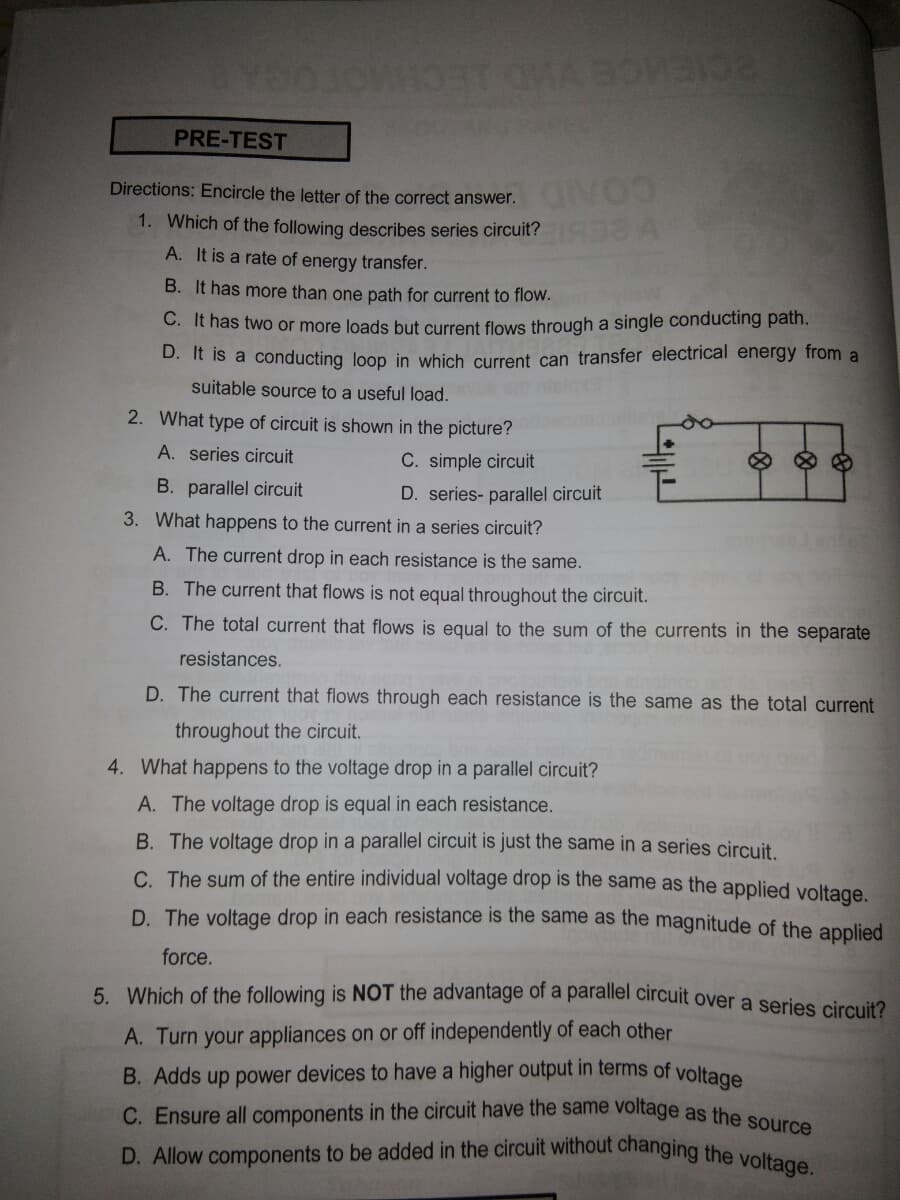1. Which of the following describes series circuit? A. It is a rate of energy transfer. B. It has more than one path for current to flow. C. It has two or more loads but current flows through a single conducting path. D. It is a conducting loop in which current can transfer electrical energy from a suitable source to a useful load.
1. Which of the following describes series circuit? A. It is a rate of energy transfer. B. It has more than one path for current to flow. C. It has two or more loads but current flows through a single conducting path. D. It is a conducting loop in which current can transfer electrical energy from a suitable source to a useful load.
College Physics
1st Edition
ISBN:9781938168000
Author:Paul Peter Urone, Roger Hinrichs
Publisher:Paul Peter Urone, Roger Hinrichs
Chapter23: Electromagnetic Induction, Ac Circuits, And Electrical Technologies
Section: Chapter Questions
Problem 54PE: Integrated Concepts A short circuit to the grounded metal case of an appliance occurs as shown in...
Related questions
Question

Transcribed Image Text:C. Ensure all components in the circuit have the same voltage as the source
D. Allow components to be added in the circuit without changing the voltage.
YoojowHOT OMA BO
PRE-TEST
Directions: Encircle the letter of the correct answer. V
1. Which of the following describes series circuit?
A. It is a rate of energy transfer.
B. It has more than one path for current to flow.
C. It has two or more loads but current flows through a single conducting path.
D. It is a conducting loop in which current can transfer electrical energy from a
suitable source to a useful load.
2. What type of circuit is shown in the picture?
A. series circuit
C. simple circuit
B. parallel circuit
D. series- parallel circuit
3. What happens to the current in a series circuit?
A. The current drop in each resistance is the same.
B. The current that flows is not equal throughout the circuit.
C. The total current that flows is equal to the sum of the currents in the separate
resistances.
D. The current that flows through each resistance is the same as the total current
throughout the circuit.
4. What happens to the voltage drop in a parallel circuit?
A. The voltage drop is equal in each resistance.
B. The voltage drop in a parallel circuit is just the same in a series circuit.
C. The sum of the entire individual voltage drop is the same as the applied voltage.
D. The voltage drop in each resistance is the same as the magnitude of the applied
force.
5. Which of the following is NOT the advantage of a parallel circuit over a series circuit?
A. Turn your appliances on or off independently of each other
B. Adds up power devices to have a higher output in terms of voltage
Expert Solution
This question has been solved!
Explore an expertly crafted, step-by-step solution for a thorough understanding of key concepts.
This is a popular solution!
Trending now
This is a popular solution!
Step by step
Solved in 2 steps with 1 images

Knowledge Booster
Learn more about
Need a deep-dive on the concept behind this application? Look no further. Learn more about this topic, physics and related others by exploring similar questions and additional content below.Recommended textbooks for you

College Physics
Physics
ISBN:
9781938168000
Author:
Paul Peter Urone, Roger Hinrichs
Publisher:
OpenStax College


College Physics
Physics
ISBN:
9781305952300
Author:
Raymond A. Serway, Chris Vuille
Publisher:
Cengage Learning

College Physics
Physics
ISBN:
9781938168000
Author:
Paul Peter Urone, Roger Hinrichs
Publisher:
OpenStax College


College Physics
Physics
ISBN:
9781305952300
Author:
Raymond A. Serway, Chris Vuille
Publisher:
Cengage Learning

College Physics
Physics
ISBN:
9781285737027
Author:
Raymond A. Serway, Chris Vuille
Publisher:
Cengage Learning


Physics for Scientists and Engineers, Technology …
Physics
ISBN:
9781305116399
Author:
Raymond A. Serway, John W. Jewett
Publisher:
Cengage Learning